
Frequently Asked Questions
About the ARBA
- What are the benefits of being a member of the ARBA?
- Do I have to raise rabbits or cavies to become a member of the ARBA?
- How long is my membership good for, and when can I renew?
- What do I have to do in order to become a registered breeder?
- How do I register my rabbits or cavies?
- How do I register my rabbitry or caviary?
- How can I get a breed or variety recognized that is not already in the
Standard of Perfection? - What district do I live in? Where can I find this information?
General Questions
- What breed is best for me or my children?
- How big should the pen be, and from what materials should it be made?
- Should my rabbit be kept inside or outside?
- Can I keep 2 or more rabbits together?
- What should I feed my rabbit, and how much?
- When can I sell or wean my rabbits?
- How do I stop my rabbit from biting, chewing, or urinating on the floor?
- Can I bathe my rabbit?
- What do I use for bedding?
- How long will my rabbit live?
Breeding Questions
- How do I know when my doe is pregnant?
- What should I do when it is time for the doe to give birth?
- Should I separate the doe and buck when she has the babies?
- When should I be worried if a doe has not given birth?
- My doe just had babies and isn’t feeding them. What should I do?
- My doe just had babies and they are dying. What did I do wrong?
- When can I breed/rebreed my rabbit?
Health Questions
- What vaccinations does my rabbit need?
- Can I catch anything from my rabbit or cavy?
- How do I worm my rabbit, and how often should this be done?
- Is it true that there are several antibiotics that are toxic to rabbits?
- I have an EMERGENCY with one of my rabbits or cavies!
- What are some good items to place in a first aid kit?
- My rabbit has white nasal discharge when it sneezes. What’s going on?
- The area around my rabbits lower eyes are wet and matted. What is weepy eye?
- My rabbit has abundant white, scaly, dandruff. What is this?
- What are these black crusts in the ear canal of my rabbit?
- What are sore hocks?
- My rabbit or cavy just broke his/her tooth!
- My rabbit has misaligned teeth. What is this?
Commercial Questions
- What breeds are best for meat production?
- Are there other options for meat producers?
- What type of licensing is required for meat production?
- What is the best source of information for rabbit producers?
- Where can I obtain breeding stock?
- How many does and bucks should I purchase?
- Is it best to purchase breeding age does?
- Should I purchase proven bucks?
- What is the recommended re-breeding schedule?
- How long will it take for fryers to reach 5 pounds?
What are the benefits of being a member of the ARBA?
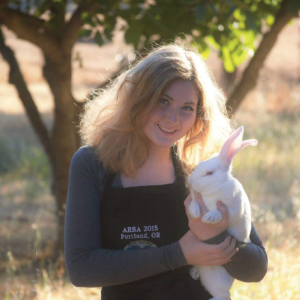 Membership in the ARBA includes a membership card, subscription to the ARBA magazine – Domestic Rabbits (published on the 15th of each odd month), the Official Guidebook – Raising Better Rabbits and Cavies (upon initial application), the option of using the Registration and Grand Champion programs, and access to a wealth of information and other materials.
Membership in the ARBA includes a membership card, subscription to the ARBA magazine – Domestic Rabbits (published on the 15th of each odd month), the Official Guidebook – Raising Better Rabbits and Cavies (upon initial application), the option of using the Registration and Grand Champion programs, and access to a wealth of information and other materials.
Do I have to raise rabbits or cavies to become a member of the ARBA?
Anyone is welcome to join the ARBA. We are a service organization that caters to anyone interested in the rabbit or cavy hobbies on a pet, fancy (exhibition), or commercial level. Are you ready to join us? Click here to join!
How long is my membership good for, and when can I renew?
The ARBA has one year or three year memberships. The term of a membership expires 1 or 3 years from the date you join, depending on the term you choose. Once you have become a member of the ARBA, you may renew at any time, and the period of renewal (1 or 3 years) is simply extended from your current expiration date. Your expiration does not change once you have become a member, unless special circumstances warrant such. You do not have to wait until your membership is expired, or is due to expire, before you can renew. Notices are mailed one month prior to your expiration date as a reminder, and also one month after your expiration date if a renewal is not received.
What do I have to do in order to become a registered breeder?
There is really no status of a “registered breeder” as far as the ARBA is concerned. Anyone may breed and raise rabbits or cavies by simply starting with a male and female. You may wish to check with your local authorities however, to insure there are no ordinances against you raising rabbits or cavies. The ARBA offers the privilege to members of registering their rabbits, cavies, rabbitry or caviary name, however; this is not necessary in order to be a member of the ARBA.
How do I register my rabbits or cavies?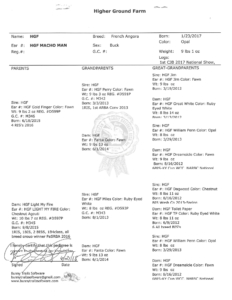
In order to register your rabbits or cavies, you must be a member of the ARBA. The rabbit or cavy must be at least 6 months of age, and you must have a 3 generation pedigree for the animal being registered. The pedigree must show the name and/or ear number, weight, and variety of the parents, grandparents, and great-grandparents (3 generations) of the animal being registered. (All ancestors in the 3 generations MUST be of the same breed as the animal being registered.) A licensed Registrar for the species must examine the animal and fill out an application for registration, which is sent to the ARBA office. The information for the registered animal is then entered into our computer system which will create a record of that animal for all time. A certificate of registration for the animal is then sent to you, the owner. Registration fee for a rabbit or cavy is $6.00 per animal.
How do I register my rabbitry or caviary?
In order to register your rabbitry or caviary, you must be a member of the ARBA. You would fill out a Rabbitry/Caviary registration form and submit it to the ARBA office. On this form is your information (name and address), and the name of the rabbitry or caviary you wish to register. Our files are checked to insure the name is not already registered by someone else, as the same name cannot be registered by more than one person. It is a good idea to list 3 choices on the registration form, in case your original choice is already taken. Once processed, a certificate of registration for your rabbitry or caviary is sent to you. The fee for registering a rabbitry or caviary is $5.00 for the name and one owner. Additional owners may be added for $2.00 per person. Once a rabbitry or caviary is registered, it is good for as long as all members listed as owners remain ARBA members in good standing. If one person listed as an owner allows their ARBA membership to lapse, the rabbitry/cavy registration becomes void. It is then necessary to re-register the rabbitry again.
How can I get a breed or variety recognized that is not already in the Standard of Perfection?
In order to introduce a new breed or variety of a rabbit or cavy which is not already recognized by the ARBA, you must first obtain a Certificate of Development (COD) for the proposed breed or variety. This can be done by submitting a letter requesting the COD with a written proposed standard for the breed or variety, and accompanied with a non-refundable fee of $50.00. You must have been a member of the ARBA for 5 continuous years at the time of application. Upon approval by the ARBA Standards Committee of the materials submitted, a Certificate of Development will be issued. There are further criteria and details which can be found in the ARBA Standard of Perfection or by contacting the ARBA office.
What district do I live in? Where can I find this information?
The ARBA is divided into districts. Click here to visit the Officers and Directors page to find your district and your representative.
What breed is best for me or my children?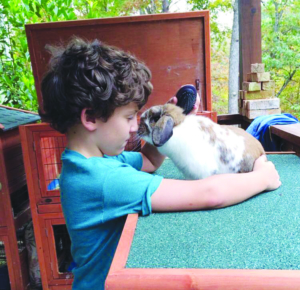
Click here to explore and learn about each breed. Rabbits and cavies are much like humans, in that each has their own disposition, characteristics, and temperament. It is nearly impossible to rubber-stamp a breed as being docile, aggressive, mean, etc. It all depends on the individual animal. In most cases, if the animal is obtained at an early age (6 – 8 weeks recommended), and handled as much as possible so it becomes aware it is in no danger or jeopardy, it will become accustomed to being handled and should enjoy being held as much as you enjoy holding it. Rabbits are timid creatures, and frighten easily. Fast movements and loud noises may frighten them, and if so, they may struggle or try to get away and hide. In so doing, they may scratch or occasionally nip at you, however; such behavior originates out of fright – not aggressiveness. This should be considered if your rabbit will be around young children. Consider the end goal as it applies to your rabbit. Base your decision regarding a particular breed on the proper size for your unique situation. Smaller breeds (compact varieties), mature quicker, and can be introduced into breeding programs sooner than medium or giant breeds. If a breeding project is something you have considered, note that the smaller breeds require less pen space, and less feed. Plan to attend a rabbit show and observe the various breeds, sizes, colors. Speaking with breeders may be the best way to determine which breed will be best for you.
How big should the rabbit’s cage be, and what materials are best?
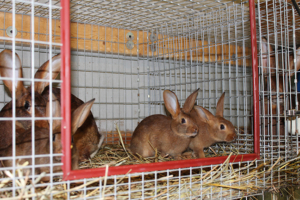
According to recommendations found in the Animal Welfare Act, the minimum floor space is calculated by the weight of the mature animal:
Breeds weighing less than 4.5 lbs
1.5 sq ft
Breeds weighing 4.5 to 9 lbs
3 sq ft
Breeds weighing 9 to 12 lbs
4 sq ft
Breeds weighing over 12 lbs
5 sq ft
Doe with litter (under 4.5 lbs)
4 sq ft
Doe with litter (4.5 to 9 lbs)
5 sq ft
Doe with litter (9 to 12 lbs)
6 sq ft
Doe with litter (over 12 lbs)
7.5 sq ft
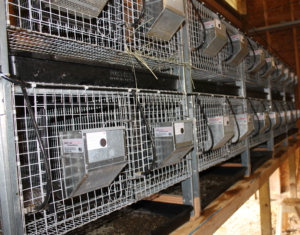 Recommended minimum height for all breeds is 14 inches. When calculating square feet, it is important to subtract feed and water dishes that occupy floor space. For this reason, feeders and water bottles (or water nipples attached to an automatic or semi-automatic water delivery system), that attach to the wire of the cage front are recommended for their efficiency and the fact that they free up valuable floor space. Naturally, a larger pen is not harmful. How much larger is at your discretion. Building materials can vary from wood, to PVC plastic, to wire. The design of your pen is up to you, and how elaborate you wish to get. The the most common pen is made of all wire, which is the most sanitary, as the waste from the rabbit will fall through the wire floor onto the ground or into a pan which can slide out from under the pen for cleaning. This latter method is a great space saver, as pens can be stacked on top of each other.
Recommended minimum height for all breeds is 14 inches. When calculating square feet, it is important to subtract feed and water dishes that occupy floor space. For this reason, feeders and water bottles (or water nipples attached to an automatic or semi-automatic water delivery system), that attach to the wire of the cage front are recommended for their efficiency and the fact that they free up valuable floor space. Naturally, a larger pen is not harmful. How much larger is at your discretion. Building materials can vary from wood, to PVC plastic, to wire. The design of your pen is up to you, and how elaborate you wish to get. The the most common pen is made of all wire, which is the most sanitary, as the waste from the rabbit will fall through the wire floor onto the ground or into a pan which can slide out from under the pen for cleaning. This latter method is a great space saver, as pens can be stacked on top of each other.
For further details and for housing recommendations for cavies, please refer to:
ARBA Recommendations for the Care of Rabbits and Cavies.
Should my rabbit be kept inside or outside?
It is your choice whether to keep your rabbit inside or outside. Rabbits can adapt very easily to varying environments and conditions however; it should be kept in mind that rabbits need to be protected from the elements at all times. They should not be kept any place where they would be in a direct draft; come into contact with rain, snow, etc; or anywhere they would be in the direct sunlight. Rabbits are wearing a fur coat, so they can withstand colder temperatures much better than they can withstand heat. If kept outside, it is good to envision how you will protect the animal from the elements before bringing it home. Building or purchasing a pen that will provide the necessary protection from the elements should be first and foremost in planning for your rabbit.
Can I keep 2 or more rabbits together?
Rabbits are very territorial, and in most cases, if multiple rabbits are kept together, they will end up fighting at some point. When reaching sexual maturity, rabbits may become aggressive and start positioning for dominance, which can lead to fighting. They most often are satisfied to be alone, and having a partner to live with is not necessary. This is especially true if you provide care and attention to your rabbit on a daily basis. There are, however; cases where multiple rabbits have been successfully kept together without fighting. If you wish to have more than 1 rabbit share the same space, we suggest introducing them at a young age – keeping a close watch for aggressive behavior. If this should occur, be ready to separate them in order to prevent injury to any of the animals.
What should I feed my rabbit, and how much?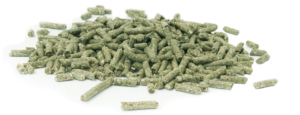
There are a number of commercially made rabbit feeds available. These have been scientifically formulated to provide a well balanced diet with all of the nutrients needed for a rabbit to grow and remain healthy. Check your local feed or animal supply stores for brands that are available in your area. Overfeeding can be your rabbit’s worst enemy. Becoming “over fat” can shorten the longevity of a rabbit and present problems for reproduction, as well as other complications. The amount of feed your rabbit will consume depends greatly on the breed and size of the animal. Normally, smaller breeds will consume 3 – 5 ounces of feed per day, while larger breeds will consume 6 – 10 ounces daily. Some rabbits will require slightly more feed than others of the same breed, depending on their individual characteristics. You must learn what the appropriate amount of feed for your rabbit is without overfeeding. Supplements or treats can be offered however; green leafy substances are NOT recommended (with exception of alfalfa hay). Again, commercially made rabbit pellets offer a balanced, nutritional diet. It is not necessary to offer treats or supplements however; if you do, treats should be given in moderation.
When can I sell or wean my rabbits?
 Under normal conditions, rabbits can be weaned anytime after they are 6 – 8 weeks of age, depending on how well they have grown and how much they are eating on their own. Once they appear to be eating and drinking on their own, they can be separated from the mother and moved to individual pens. Several weanlings can be grouped together for a limited time until they have further developed. When selling a rabbit, whether they are young or old, it is a good idea to offer some feed to the new owner. It can be mixed with their feed, if they have a different brand, so the animal is not switched from one feed to another without a transition period. Caution should be exercised so as to not remove kits from their mother too early, or to sell young rabbits before they have grown and developed to the stage where they are eating and drinking well, and can survive on their own.
Under normal conditions, rabbits can be weaned anytime after they are 6 – 8 weeks of age, depending on how well they have grown and how much they are eating on their own. Once they appear to be eating and drinking on their own, they can be separated from the mother and moved to individual pens. Several weanlings can be grouped together for a limited time until they have further developed. When selling a rabbit, whether they are young or old, it is a good idea to offer some feed to the new owner. It can be mixed with their feed, if they have a different brand, so the animal is not switched from one feed to another without a transition period. Caution should be exercised so as to not remove kits from their mother too early, or to sell young rabbits before they have grown and developed to the stage where they are eating and drinking well, and can survive on their own.
How do I stop my rabbit from biting, chewing, or urinating on the floor?
Rabbits are each unique in their own personal characteristics. If you find your rabbit is exhibiting negative behaviors such as: biting, chewing, or “marking its territory” by urinating, you need to try and resolve the situation. Many people will scold the rabbit by making a loud noise such as clapping their hands, or rolling a newspaper up and slapping their leg or hand. The loud noise warns the rabbit it is doing something it should not. Neutering your rabbit may help to calm its disposition and bad habits also, but would stop any reproduction for that animal, and will prevent the animal from being shown at an ARBA sanctioned rabbit show.
Can I bathe my rabbit?
Rabbits are generally very clean animals and rarely require a bath. The average rabbit will groom itself as much or even more than your pet cat! If your rabbit has a soiled rear end, rinsing it off with clear water is clearly needed, but bathing the entire rabbit with shampoo is generally not advised. Rabbit fur will take several days to dry, resulting in a very uncomfortable rabbit when the entire rabbit is shampooed. Angora breeders will blow their show rabbits by using a hair dryer on cold or warm which blows out dirt and loose hair.
What do I use for bedding?
In solid-bottomed cages, most use pine shavings. Cedar shavings have a resin which may be toxic. For wire-bottomed cages, bedding increases the incidence of unsanitary conditions, making clean-up a chore – creating more problems than it is worth. For the rabbit keeper who feels bedding is needed in a wire-bottomed cage, straw – especially in front of the feeder, is best – leaving the back of the cage with bare wire flooring so urine and droppings can fall through. Plastic floor pieces (“Mighty Mat”) are also useful for rabbits with thin foot pads that are prone to developing “sore hocks”.
How long will my rabbit or cavy live?
The “average” life expectancy of a rabbit is between 7 – 10 years, given the proper diet and kept in good sanitary conditions. Cavies generally live for 4-5 years. Naturally, there are exceptions and many rabbits may not reach their 7th year and rarely some may live past 10 years of age.
How do I know when my doe is pregnant?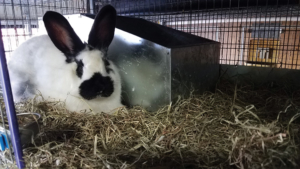
Palpating the doe would be the only sure way of detecting pregnancy prior to the actual delivery of a litter. This is a process of “feeling” the embryos inside the doe. It takes practice, and can be harmful to the doe and litter if done incorrectly. For the novice, it is sometimes just better to just wait the duration of the gestation period and hope the doe kindles a live and healthy litter. The gestation period of a rabbit is 28 – 32 days. Palpation should be attempted around days 10-12. At this stage, the embryos in a mother rabbit?s uterus will be about the size of a penny. Gently use your dominate hand to palpate the area of the belly directly in front of the hips.
What should I do when it is time for the doe to give birth?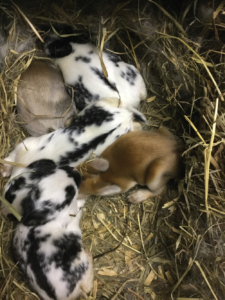
Kindling (giving birth) occurs between 28 – 32 days with 31 days being average. You should be sure to mark down the date when your doe was bred. A nest box should be provided to the doe about 25 to 27 days after the date she was bred. The box should be filled with a nesting material, such as straw, grass hay, and/or soft pine shavings that she can use to build a nest. In most cases, the doe will also pull some of her fur which she mixes with the nesting materials, and additional fur to cover her litter which acts as a blanket for the newborn kits. The nest box should be about 2 – 4 inches longer and wider than the doe herself. Larger boxes may encourage her to use it as a resting place or “toilet”, and she may foul the box. After you believe the doe has had her litter (if any signs indicate such), it is good to try and check the box. Remember, the doe may be protective of her newborn kits, so be careful. Remove any afterbirth or dead babies from the box, as if allowed to decay in the box, the doe may abandon the remaining live kits due to the unpleasant smell. Mother nature should take her course and the doe should raise the kits with no problem. If you encounter something that does not seem ordinary, contact us and we will try to be of assistance to you.
Should I separate the doe and buck when she has the babies?
Actually, a mature doe and buck should not be kept in the same pen at any time. Doing so can result in an unplanned pregnancy, and possible fighting and injury to one or both of the animals. If you feel the two animals need to be together for companionship, it is best to have them in separate pens which are located so they can see each other.
When should I be worried if a doe has not given birth?
In general, any pregnancy that lasts beyond 35 is abnormal and may be classified as dystocia (difficult birth). These mother rabbits are at high risk of complications and may need assistance from you (the breeder) or a veterinary professional.
My doe just had babies and isn’t feeding them. What should I do?
Does only nurse their litters once 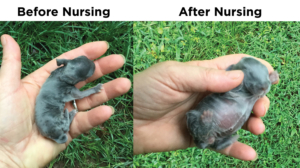 or twice a day, and only for about 5 minutes, so it is possible she is feeding the litter and you haven’t seen her. Litters that are being nursed have bellies at least as large as the rib cage, if not larger. These litters are warm and covered with hair, and the babies seem comfortable. When the litter is not being fed, the abdomens are smaller than the rib cage, the litters may seem the same temperature or cooler than your hand, and are very active when you touch the nest as they know they only have a couple of minutes to nurse. If truly the doe is not nursing, holding her on her back to let the babies find a teat is the most common practice. Milk letdown can be improved with shots of oxytocin which is a prescription drug. Fostering young to other mothers that have kindled at a similar date to the original mother is also an option as well. Bottle feeding can be done in rabbits via a mixture of fresh whole goat milk, kitten milk replacer, and whole cream. Warm the mixture prior to feeding.
or twice a day, and only for about 5 minutes, so it is possible she is feeding the litter and you haven’t seen her. Litters that are being nursed have bellies at least as large as the rib cage, if not larger. These litters are warm and covered with hair, and the babies seem comfortable. When the litter is not being fed, the abdomens are smaller than the rib cage, the litters may seem the same temperature or cooler than your hand, and are very active when you touch the nest as they know they only have a couple of minutes to nurse. If truly the doe is not nursing, holding her on her back to let the babies find a teat is the most common practice. Milk letdown can be improved with shots of oxytocin which is a prescription drug. Fostering young to other mothers that have kindled at a similar date to the original mother is also an option as well. Bottle feeding can be done in rabbits via a mixture of fresh whole goat milk, kitten milk replacer, and whole cream. Warm the mixture prior to feeding.
My doe just had babies and they are dying. What did I do wrong?
Chilling or hypothermia is the most common cause of newborn babies dying. Be sure the doe has a nest box that is bedded with hay, straw, or other soft bedding and she has pulled fur from her body to serve as a blanket. Does often lose their first litters. Rebreeding 5 days later often produces better results. Having rabbits kindle when the temperature is below 60 degrees requires frequent checking on the does. Heat lamps and nest box warmers can cook a litter so frequent monitoring is required. Insulation under nest boxes improves warmth of the nest in cold winter, but over-heating a litter is still possible. Waiting for late spring or summer will make kindling easier, but the hot summer will bring new problems with heat prostration and the risk of death for both the doe and her kits.
When can I breed/rebreed my rabbit?
Does can be rebred as little as 2 weeks after kindling in intensive commercial situations, but more commonly, they are rebred when their litter is 6 weeks old or even after weaning depending on how fast they recover from the previous litter. With show rabbits, breeding schedules may allow for only 2 litters a year – one in the spring and the other in the fall, but reduced fertility will occur with this schedule.
What vaccinations does my rabbit need?
There are no approved vaccines for rabbits or cavies. There is no licensed rabies vaccine for rabbits or cavies so they should not be vaccinated for this. Even though this has been required by some fair shows, it has been associated with death of the rabbits.
Can I catch anything from my rabbit or cavy?
We call diseases that are transmissible from humans to animals (and vice versa) a zoonotic disease. There are several noteworthy conditions you should be aware of in rabbits and cavies: Rabbits: allergies (skin and urine), Bordatella, rabbit fever (wild rabbits primarily), Pasteurella, E. cuniculi (in extremely immunocompromised patients), fur mites. Cavies: allergies (skin and urine), Bordatella, salmonella, Streptococcus, fungal skin infections, and sarcoptic mites in the skin.
How do I worm my rabbit, and how often should this be done?
The common intestinal parasites that domestic rabbits can be infected with include pinworms, tapeworms, flukes, and coccidia. Pin worms are thread-sized and approximately one inch long. If an infestation is present, the pinworms can be seen protruding from the droppings or in herd situations. Piperazine, a product sold for livestock, can be mixed in the water at livestock dosages. When pin worms are seen in one rabbit in a herd, treat the entire herd as the worm quickly spreads through the rabbitry. Worming once a week for 3 weeks is indicated to be sure all the immature forms are killed. Watch droppings closely as this proves that the worms are gone and have not come back. Coccidia are a protozoal parasite that requires microscopic confirmation at your local veterinarian and cannot be seen with the naked eye. Very young rabbits will stop eating, become dehydrated, and may or may not have diarrhea. Because these signs are vague and can be due to other problems, it is good practice to use coccidiostats routinely in your herd. The medication Corid, commonly used for poultry, can be used at a dose of 0.5 cc?s per 500 mL (17 oz.) of water. It is recommended that the herd be treated for at least five days to ensure all rabbits have ingested the medication.
Is it true that there are several antibiotics that are toxic to rabbits?
YES! The following medications should not be used if another alternative is available:
- Amoxicillin or Amoxicillin/clavulanic acid
- Ampicillin
- Cephalosporins
- Clindamycin
- Erythromycin
- Lincomycin
- Penicillin (orally only; Penicillin can be used parenterally in rabbits)
I have an EMERGENCY with one of my rabbits or cavies!
We do our best at the ARBA to provide timely advice in cases of emergencies. Problems occur around the clock and frequently require immediate veterinary attention. In these cases, we recommend that you bring your rabbit or cavy to a veterinarian as soon as possible. When deciding on which hospital to bring your animal to, please research the clinic thoroughly to ensure that the doctors are comfortable and competent in seeing ?exotics? which include rabbits and rodents. Veterinarians who see companion animals only may not include exotic species.
What are some good items to place in a first aid kit?
- Antibiotics: PPG (Penicillin-Procaine G), Terramycin ophthalmic ointment (oxytetracycline with polymixin B), Terramycin soluble powder (oxytetracycline)
- Anthelmintics (Anti-parasites): Ivermectin, Fenbendazole, Corid, Piperazine
- Anticoagulants (bleeding nails): Kwik Stop (Styptic), corn starch
- Bandages: Gauze pads, vetwrap, ace bandage
- Critical Care: Sub-Q (subcutaneous) fluids (LRS, Plasmalyte, 0.9% NaCl), Oxbow Critical Care, Rabbit Nutri Drops, Acid Pack 4-Way, Fast Track
- Hypodermic needles & Syringes: 22 gauge for injections, 20 gauge for SQ fluids
- Healing: Silver Sulfadiazene, Preparation H
- Teeth & Nails: Toenail clippers, wire cutters
My rabbit has white nasal discharge when it sneezes. What’s going on?
Any rabbit with thick, white (or off white) nasal discharge likely has an upper respiratory infection. These are fairly common in domestic rabbits and relatively easy to treat but many times difficult to completely cure. Many rabbits respond well to antibiotics given twice daily for 2-4 weeks at a time. Most of these medications are obtained through a licensed veterinarian. Please be aware that upper respiratory infections are transmitted via the air. Do not house the sick rabbit near other rabbits or bring him/her to a rabbit show!
The area around my rabbits lower eyes are wet and matted. What is weepy eye?
Weepy eye is the infection and/or inflammation of the conjunctiva (the eyelids), nasolacrimal duct (the tube that connects the eye to the nose), or both. Rabbits will have marked wetness around the eyes and may cause them to lose hair there. This condition can be treated with antibiotic drops or ointments that include Oxytetracycline, Gentamicin, or Ofloxacin drops.
My rabbit has white, scaly, dandruff on its skin. What is this?
There is a good chance that your rabbit has fur mites. These microscopic mites burrow through the skin and hair causing large flakes (dandruff) to come off the rabbit. It is most common around the nape of the neck. Ivermectin 1% at a dose of 0.02 cc?s per pound of body weight given orally or subcutaneously is an effective treatment. Treat two weeks after the first dose to ensure the mites are gone.
What are these black crusts in the ear canal of my rabbit?
Ear mites are common in rabbits and cause large crusts and scabs in the ear canals. They can be effectively treated with Ivermectin 1% at a dose of 0.02 cc?s per pound of body weight given orally or subcutaneously is an effective treatment. Treat two weeks after the first dose to ensure the mites are gone.
What are sore hocks?
These are inflamed, ulcerated areas of the hock (the back of the foot, or ankle) and commonly affect Rex breeds of rabbits or breeds over 7 pounds. This can be due to sitting on a wire bottom cage for too long which erodes the protective layer of fur on the hock. Provide a solid resting place for the affected rabbit and consider a topical cream or salve to assist with healing.
My rabbit or cavy just broke his/her tooth!
Fear not! Because rabbits teeth erupt continuously throughout their life, the tooth will grow back in the next few weeks.
My rabbit has misaligned teeth. What is this?
This is called malocclusion in rabbits. Normal rabbits have the upper incisors overlap the lower incisors. The teeth move against each while eating and prevent them from getting longer. The simple form happens when the incisor teeth meet head on and do not overlap. The advanced form, sometimes called ?wolf teeth? occurs when the upper or lower incisors are deviated in a way that allows them to continuously grow. This condition must be corrected by clipping the teeth periodically or they will eventually prevent the rabbit from eating.
What breeds are best for meat production?
Although there are a number of breeds with the body type suitable to the commercial meat venture, the most popular is the New Zealand White followed by the Californian. A crossbred fryer from these two breeds is also acceptable to many processors. Before venturing into a meat producing enterprise with the intent to sell to a processor, contact the buyer to determine the preference and select your breed(s) accordingly.
Are there other options for meat producers?
Some producers have found it advantageous to process and market their fryers instead of selling to a processor. States have regulations regarding the marketing of meat for human consumption. Regulations will vary from state to state. Begin with the regulations published by the State Agriculture Department or the Health Department. In addition, the pet food market offers many possibilities for rabbit producers. Check with licensing requirements before venturing into this area.
What type of licensing is required for meat production?
It would be advisable to investigate your local zoning laws regarding the establishment of the rabbitry. If located within an incorporated city, it would be expected to see some type of restrictions. In some cases, this might extend into the county as well.
Usually no licensing is required for the production of rabbits for meat as long as the zoning requirements are not violated. However, that is not true when the production of rabbits extend to the ‘pet’ market. It is possible that the rabbitry would need to be licensed and inspected under the guidelines of the Animal Welfare Act enforced by the U.S. Department of Agriculture. In short, licensing is required for breeders who supply more than $500 of rabbits to a wholesale facility/buyer. Direct pet sales to the consumer are not included in the $500 threshold. If there are no pet sales to a wholesale or resale facility, inspections by the USDA are not required. The $500 threshold also covers producers supplying rabbits to research facilities.
What is the best source of information for rabbit producers?
Become an ARBA member and receive the Official Guidebook entitled “Raising Better Rabbits & Cavies”.
Where can I obtain breeding stock?
It is important to begin with good stock bred for meat production. Many processors will be able to provide a referral.
How many does and bucks should I purchase?
Have you previously had experience with rabbit production? If not, it is advised to start with twenty to thirty does and three or four bucks. In doing so, you can acquire good management skills without becoming overwhelmed.
Is it best to purchase breeding age does?
It would be rare to find producers who are able to provide large quantities of young ready-to-breed or proven does. It is often recommended that does, eight to ten weeks old be purchased for development within your facility which allows them to become accustomed to the environment before the initial stress of the first time kindling.
Should I purchase proven bucks?
Purchasing at least one young proven buck is recommended by many breeders.
What is the recommended re-breeding schedule?
There are several schools of thought regarding the most profitable re-breeding schedule. Although many producers will re-breed at 11, 14, 21 or 28 days after kindling, there are some producers who follow a 42 day re-breeding schedule. In most instances, this 42 day schedule allows for the marketing of fryers directly from the maternity cage and allows a period of rest for the doe before the next kindling. This reduces the need for a lot of finishing cages for the fryers. Re-breeding on a more intensive schedule calls for additional cages for the fryers during the growing/finishing time as well as manpower to wean and physically move the fryers.
If two barns are equipped with the same number of cages, the 42 day re-breed facility will have more does in production than a facility with a more intensive re-breed schedule. The difference is that finishing cages would be required in one facility and not in the other. It must be noted that the resulting fryer production could be the same for both facilities.
How long will it take for fryers to reach 5 pounds?
Growth rate is affected by genetics, ration consumed, litter size weaned, temperature, and cage stocking rate. The general expectation for quality commercial-type fryers is to reach 5 lbs. within 8 to 10 weeks post kindling.